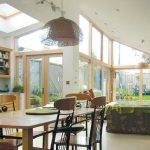Lime Wash
As an external decorative and protective finish, limewash has been around for at least ten thousand years! Essentially what is being applied is calcium hydroxide suspended in water. As the water evaporates, the calcium hydroxide readily combines with carbon dioxide in the atmosphere to form calcium carbonate (a process known as carbonation). These crystals are unusual in that they have a dual refractive index; light entering each crystal is reflected in duplicate. This results in the wonderful surface glow that is a unique characteristic of limewashed surfaces.
It’s fair to say that when limewash was discovered, the primary aim was not a decorative finish to impress the neighbours! Its value lay in the protection it offered the dwelling against the elements.
Since limewash is one of the most vapour permeable decorative coatings, it undoubtedly assists in maintaining the ability of a building to breathe. In fact, tests show that limewash has a vapour permeability rating of about 350 units, while many masonry paints are well below 75 units. If a building is prevented from breathing, water vapour may condense in the colder external walls, resulting in the decay of the masonry and producing ideal conditions for timber to rot. To add to the damage, heating bills rise as a damp wall transmits heat faster than a dry wall. The use of lime wash internally on plaster is mainly decorative, but on external renders, its protective qualities are essential.
Limewash is not difficult to produce providing that a few simple but important rules are observed. Once the quicklime has been slaked, the putty should be left for at least three months to ensure that all the quicklime has reacted with the water and that the particles of lime have started to mature.
The putty is then sieved to exclude any foreign material (even the finest and purest naturally occurring limestone will contain some contaminants). The limewash should then be applied as thinly as possible to facilitate carbonation and prevent crazing which can happen if it is applied more liberally. (Limewash is normally applied to a sympathetically porous background such as sandstone, lime plaster, clay bricks or lime render). At this point binders, such as raw linseed oil, can be added to the basic limewash, which will help it to adhere by making it moisture droplet resistant while, at the same time, remaining vapour permeable.
It is essential to choose a period of fine weather before applying limewash externally since a fresh coat is vulnerable to dilution by rain. This will manifest itself as white streaks running down the wall or the colour may wash out. Even when the application has been kept as thin as possible, it may take several days before it can be safely overcoated, so it is advisable to leave it for at least five days before any further work is carried out.
New lime products include insulated lime render where cork aggregates are incorporated and mixed with the lime. This new render product comes in premixed bags and only requires the addition of water on site before being manually applied or sprayed with a standard render pump machine. It offers similar insulating properties as polystyrene, with the added benefit of providing a high level of breathability. Therefore, these products are ideal for the retrofitting of old stone buildings while improving the U-value of the wall. Like standard lime renders, they can be used internally and externally. These products have developed into a very successful DIY, cost effective system on the continent for the retrofitting of old stone houses and historic buildings.
Specials
Into this category fall the metals including stainless steel, aluminium, zinc and copper as well as ceramic and clay tiles and those made from composite materials, mesh and cementitious boards. In fact possibly the only limiting factor in the choice of a facade is your budget! These finishes tend to be very low or no maintenance, come in a wide variety of colours and the individual sections can be replaced. They are most commonly seen in commercial buildings but are occasionally used domestically.
The newest kid on the block is a material that has a long and distinguished history: cork. Cork’s natural insulation properties have been known and used in many ways for hundreds of years so perhaps it should not be a surprise that yet another product is making news. Cork has an extremely low thermal conductivity so walls lined with it lose heat slowly, and it’s the only completely carbon negative building material. Its properties have recently been put to the test on the north facing external wall of a Victorian terrace house in London to try to reduce heat loss. Dark brown 180mm boards were attached to the facade and the heat loss has now reduced by 10%. Air pockets in the cork trap heat and although it gets wet when it rains, moisture does not penetrate fully and the boards just dry out again when the rain stops. It’s naturally mould resistant so doesn’t rot either. As an insulator cork competes well on cost with newer materials, or better, as it doesn’t require finishing.







